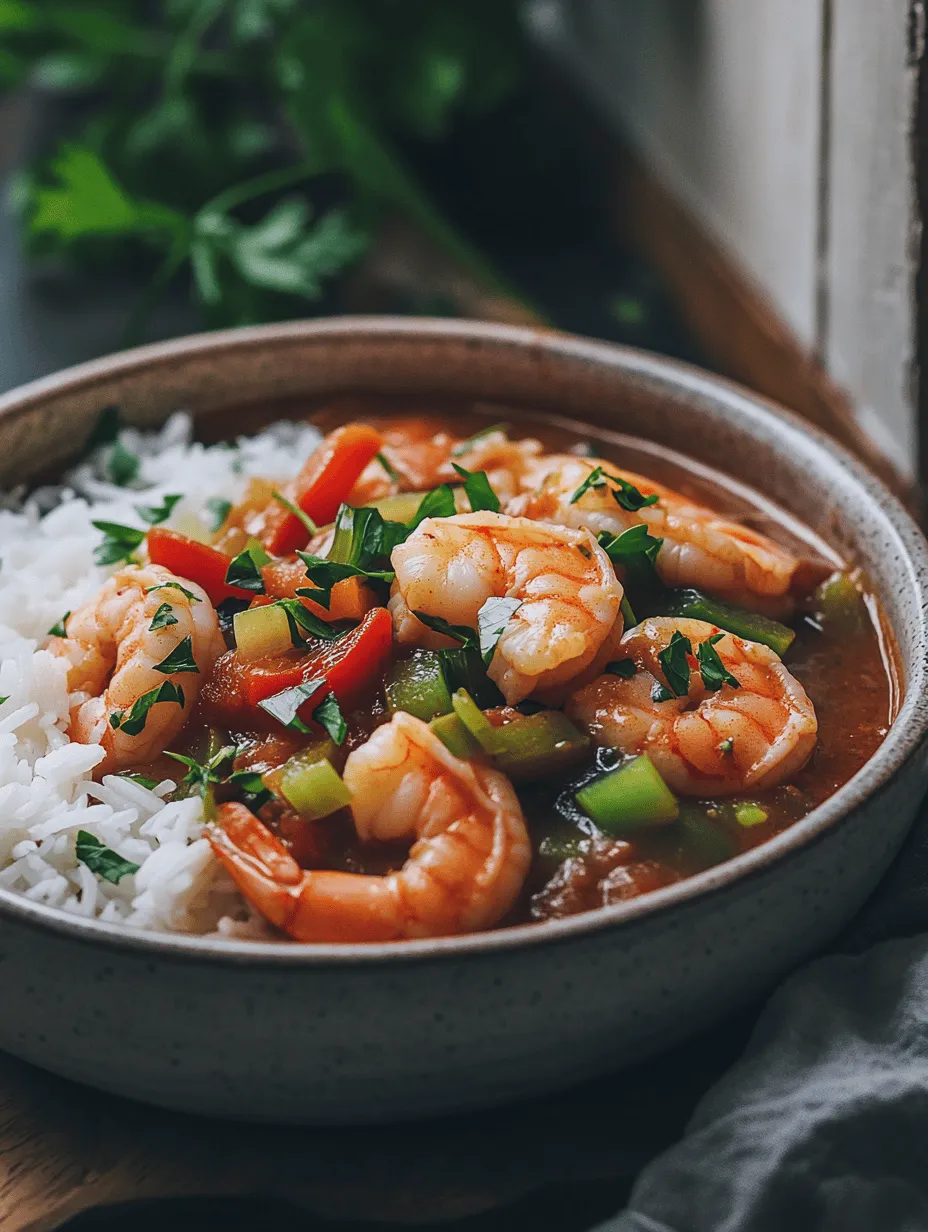Introduction to Shrimp Étouffée: A Southern Delight
Immerse yourself in the rich and captivating culinary tradition of Southern cooking with our delightful Shrimp Étouffée recipe. This iconic dish hails from the vibrant state of Louisiana, where Creole and Cajun influences collide to create a symphony of flavors that celebrate the region’s cultural heritage. Shrimp Étouffée is not just food; it’s an experience—a comforting, flavorful dish that embodies the essence of Southern hospitality.
The term “étouffée” translates to “smothered” in French, aptly describing the method of cooking where shrimp is enveloped in a luscious sauce made from a base of roux, vegetables, and spices. Whether you’re hosting a dinner party or enjoying a quiet night at home, this dish is sure to impress your family and friends alike with its aromatic allure and satisfying taste.
In this article, we will take you through the process of crafting a succulent Shrimp Étouffée with a unique Southern twist. We will provide detailed insights into each step of the recipe, ensuring that both seasoned cooks and kitchen novices can master this dish. From selecting the freshest shrimp to perfecting the flavors, you will find everything you need to create a classic Southern meal that warms the heart and delights the palate.
Understanding the Essence of Étouffée
What is Étouffée?
To truly appreciate Shrimp Étouffée, it’s essential to understand its history and significance in Southern cuisine. This dish has its roots deeply embedded in the cultural tapestry of Louisiana, combining elements of French, Spanish, and African culinary techniques. Étouffée is traditionally associated with Creole cooking, characterized by its use of seafood and a rich blend of spices.
The origins of étouffée can be traced back to the 18th century, when French settlers introduced the concept of smothering meat or seafood in a thick sauce. Over time, the dish evolved, with shrimp becoming a popular choice due to its abundance in the coastal waters of Louisiana. Today, there are numerous variations of étouffée, each with its own unique twist, but at its core, the dish remains a celebration of the region’s bountiful seafood and vibrant flavors.
Key Ingredients That Make Étouffée Special
The beauty of Shrimp Étouffée lies in its simplicity and the quality of its ingredients. Here’s a breakdown of the primary components that contribute to this dish’s distinctive flavor profile:
1. Fresh Shrimp: The star of the dish, shrimp provides a sweet and briny flavor that pairs beautifully with the rich sauce. Sourcing the freshest shrimp is essential, as it directly impacts the overall taste of the étouffée.
2. Roux: This is the foundation of many Southern sauces, and it plays a pivotal role in flavor development. A well-made roux adds depth and complexity to the dish, creating a velvety texture that envelops the shrimp.
3. The Holy Trinity: This term refers to a classic combination of onions, bell peppers, and celery—essential vegetables in Southern cooking. These ingredients provide a fragrant base that enhances the dish’s overall flavor.
4. Garlic: Adding a punch of aroma and taste, garlic elevates the dish, bringing an extra layer of flavor to the sauce.
5. Cajun Seasoning: A blend of spices that typically includes paprika, cayenne pepper, garlic powder, and onion powder, Cajun seasoning imparts warmth and complexity to the dish.
6. Dried Thyme: This herb complements the other ingredients, adding a subtle earthiness that rounds out the flavor profile.
7. Stock or Broth: A good quality seafood stock or chicken broth is crucial for the sauce, as it infuses the dish with additional flavor.
Each ingredient in Shrimp Étouffée serves a purpose, contributing to the overall harmony of flavors that makes this dish a true Southern delight.
Preparing for Success: Gathering Your Ingredients
Before diving into the cooking process, it’s essential to gather your ingredients and ensure you’re equipped with everything you need. This preparation will set the stage for a successful cooking experience.
Fresh Shrimp: Choosing the Best Quality
When it comes to shrimp, quality is paramount. Look for shrimp that is labeled as “wild-caught” for the best flavor and texture. Freshness is key; the shrimp should have a mild, ocean-like smell, and the shells should be firm and shiny. If possible, opt for shrimp that are still in their shells, as they tend to retain moisture and flavor better during cooking.
Consider the size of the shrimp as well; larger shrimp (16-20 count per pound) are often recommended for étouffée, as they hold up well in the sauce and provide a satisfying bite. Additionally, pay attention to sustainability practices, opting for shrimp sourced from responsible fisheries to support the health of our oceans.
The Importance of a Good Roux
A roux is a mixture of equal parts fat and flour, cooked together to create a thickening agent for sauces and soups. It’s a defining element in many Southern dishes, including étouffée, and it’s where much of the flavor is developed. Achieving the perfect roux is crucial, as it can make or break your dish.
To make a roux, start by selecting a fat—traditionally, a combination of butter and oil works beautifully. Place the fat in a heavy-bottomed pot over medium heat and gradually add the flour, stirring constantly. The goal is to cook the mixture until it reaches a deep golden brown color, which can take anywhere from 15 to 30 minutes. This slow cooking process allows the flour to toast, resulting in a nutty flavor that enhances the étouffée.
Visual cues are essential in this step; a properly cooked roux should have a smooth, velvety texture and a rich, caramel-like aroma. Be cautious not to burn the roux, as this can impart a bitter taste to the dish. If you notice it starting to darken too quickly, reduce the heat or remove it from the heat temporarily.
Essential Vegetables for Flavor Depth
The “holy trinity” of Southern cooking—onions, bell peppers, and celery—is the backbone of this Shrimp Étouffée. Each vegetable contributes its unique flavor and texture, creating a well-rounded base for the sauce.
– Onions: They provide a sweet and savory flavor that forms the foundation of the dish. Sautéing onions until they are translucent enhances their sweetness.
– Bell Peppers: These add a vibrant color and a subtle crunch. You can use any color of bell pepper, but green is traditionally used in Cajun cooking for its slightly bitter taste.
– Celery: Known for its aromatic qualities, celery adds a fresh and crisp note that balances the richness of the roux.
In addition to the holy trinity, garlic is a must-have ingredient. Minced garlic can be added to the vegetables during the sautéing process, infusing the dish with its unmistakable aroma.
Seasoning and Aromatics
The seasoning is where you can truly personalize your Shrimp Étouffée. Start with a good Cajun seasoning blend, which typically includes paprika, cayenne pepper, garlic powder, onion powder, and various herbs. This blend creates a warm, complex flavor that complements the sweetness of the shrimp.
Dried thyme is another essential herb that adds depth to the dish. It pairs well with the other ingredients, enhancing the overall flavor without overpowering it. Balancing the seasoning is key; you want the spices to elevate the dish, not drown it out.
As you prepare to cook, remember that seasoning can always be adjusted to your taste. Start with a moderate amount and add more as needed throughout the cooking process.
Step-by-Step Guide to Making Shrimp Étouffée
Now that you have gathered your ingredients and understand their significance, it’s time to get cooking! This step-by-step guide will walk you through the process of making Shrimp Étouffée, starting with crafting the perfect roux.
Crafting the Perfect Roux
1. Heat the Fat: In a heavy-bottomed pot or Dutch oven, melt 1/2 cup of unsalted butter over medium heat. Once melted, add 1/2 cup of vegetable oil to the pot. This combination helps to achieve a smooth roux without burning the butter.
2. Add the Flour: Gradually whisk in 1/2 cup of all-purpose flour. Stir continuously with a wooden spoon or a whisk to combine the flour and fat.
3. Cook the Roux: Keep the heat at medium and continue to stir the roux constantly. You will notice it begin to bubble and change color.
4. Monitor the Color: After approximately 15 minutes, the roux will start to turn a light tan color. Continue cooking and stirring, aiming for a rich, dark brown roux similar to the color of chocolate. This process can take up to 30 minutes, so patience is key. If you notice any burning or dark spots, lower the heat immediately.
5. Aroma Check: As the roux darkens, it will develop a nutty aroma. This is your cue that flavor is intensifying. Once you reach the desired color, remove the pot from the heat immediately to prevent further cooking.
The roux is the heart of your Shrimp Étouffée; it adds richness and depth that is crucial for the dish’s success. With your roux perfected, you are now ready to continue with the preparation of the shrimp and the remaining ingredients.
Stay tuned for the next part of this article, where we will explore the remaining steps to create a mouthwatering Shrimp Étouffée that captures the true essence of Southern cooking.

Sautéing the Vegetables: Building Flavor
The foundation of any great étouffée lies in its vegetables. To start, heat a generous amount of oil in a large skillet or Dutch oven over medium heat. Aim for around ¼ cup of vegetable oil or a combination of vegetable oil and butter for a richer flavor. As the oil heats, add diced onions, bell peppers, and celery—this trio is often referred to as the “holy trinity” of Cajun and Creole cooking.
Sauté these aromatic vegetables for about 5-7 minutes, stirring frequently, until they become soft and translucent. This process not only softens the vegetables but also allows their natural flavors to meld together, creating a robust base for your étouffée. To enhance the flavor further, consider adding minced garlic during the last minute of sautéing; this will infuse the dish with a delightful aroma. Avoid browning the vegetables too much; you want them tender but not caramelized, as this can alter the intended flavor profile of the dish.
Incorporating the Liquids: Creating the Base
Once your vegetables are sautéed to perfection, it’s time to create a rich, flavorful base. Gradually incorporate your seafood broth—about 2 to 3 cups—into the skillet, stirring to combine. Using homemade seafood broth will elevate the dish, but store-bought options work just as well. You can also add a can of diced tomatoes, preferably fire-roasted, for an extra layer of flavor and a hint of sweetness.
As you add the liquids, keep an eye on the consistency. The goal is to achieve a thick, stew-like texture. If it’s too thin, allow it to simmer uncovered for several minutes, letting some of the liquid evaporate. On the other hand, if the mixture appears too thick, a splash of water or additional broth can help to balance it out.
Seasoning for Success
Seasoning is crucial to achieving the perfect shrimp étouffée. Start with the traditional Cajun spices: a combination of salt, black pepper, cayenne pepper, and paprika. Add these seasonings gradually, tasting as you go to ensure the flavors are balanced. This is particularly important since the shrimp will also contribute to the overall flavor profile.
After incorporating your spices, consider adding a splash of Worcestershire sauce or hot sauce for an extra punch. The timing of your seasoning is key; it’s best to season the broth mixture before adding the shrimp, allowing the flavors to meld and permeate the dish.
Cooking the Shrimp: Timing is Key
Once your base is seasoned to perfection, it’s time to add the star of the dish—fresh, peeled, and deveined shrimp. Depending on the size of your shrimp, add them to the skillet and gently stir to combine. The critical aspect here is timing; shrimp cook quickly, so keep an eye on them. They typically require only about 3-5 minutes to cook through. You’ll know they’re done when they turn pink and opaque.
Be cautious not to overcook the shrimp, as they can quickly become tough. Once cooked, remove the skillet from the heat and let the flavors meld for a few minutes before serving.
Serving Your Shrimp Étouffée
Presentation Matters
When it comes to serving shrimp étouffée, presentation can enhance the dining experience. Serve the étouffée over a bed of fluffy white rice, which not only adds a beautiful contrast but also allows the sauce to soak into the rice, maximizing flavor.
For garnishing, finely chop green onions and fresh parsley, sprinkling them generously on top of the dish before serving. This adds a pop of color and freshness that complements the richness of the étouffée. Additionally, consider placing a lemon wedge on the side; a squeeze of fresh lemon juice can brighten the dish and enhance the flavor profile.
Pairing Suggestions for a Complete Meal
To complement the rich and comforting flavors of shrimp étouffée, consider serving it alongside a few classic Southern side dishes. Traditional pairings include cornbread, which adds a sweet, crumbly texture, or a simple green salad dressed with vinaigrette to cut through the richness of the dish.
For beverages, sweet tea is a timeless Southern choice, but a light, crisp white wine such as Sauvignon Blanc or a zesty Riesling can also pair beautifully with shrimp. If you’re feeling adventurous, try a local craft beer; a pale ale or pilsner can refresh the palate and balance the spices in the étouffée.
Nutritional Benefits of Shrimp Étouffée
Health Benefits of Shrimp
Shrimp are not only delicious but also offer numerous health benefits. They are an excellent source of high-quality protein, with a 3-ounce serving providing approximately 20 grams of protein. Shrimp are also low in calories and contain healthy fats, particularly omega-3 fatty acids, which are known to support heart health.
Additionally, shrimp are rich in essential nutrients, including selenium, vitamin B12, and iodine, which contribute to overall well-being. When prepared with vegetables and spices, shrimp étouffée becomes a wholesome dish that packs a nutritional punch.
Balancing Flavor and Nutrition
The addition of vegetables such as onions, celery, and bell peppers not only enhances the flavor of the étouffée but also boosts its nutritional profile. These vegetables provide fiber, vitamins, and minerals that contribute to a balanced meal. The spices used in the dish, like cayenne and paprika, also offer health benefits, including anti-inflammatory properties and antioxidants.
By incorporating a variety of ingredients, shrimp étouffée stands as a dish that balances flavor and nutrition, making it a satisfying choice for any meal.
Conclusion: Enjoying the Comfort of Southern Cuisine
Shrimp étouffée is more than just a meal; it’s a celebration of Southern culinary traditions and a testament to the art of cooking with love. By following this comprehensive guide, you can create a dish that not only satisfies the palate but also brings warmth and joy to your dining table. The combination of succulent shrimp, rich flavors, and a variety of textures makes this dish a standout choice for family gatherings or casual weeknight dinners.
Whether shared with family or friends, this shrimp étouffée recipe promises to deliver a memorable experience that showcases the rich flavors of the South. As you savor each bite, you’ll appreciate the heart and soul poured into this classic dish. Enjoy every moment as you indulge in the comforting embrace of Southern cuisine, and let the warmth of this delightful meal fill your home with joy.

